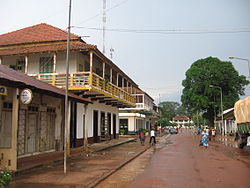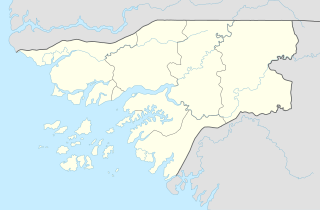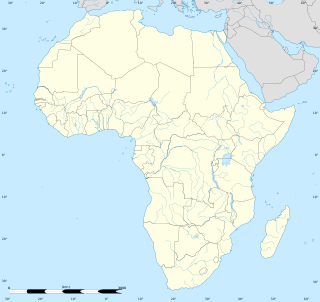Gabu (town)
Gabu
Kansala Nova Lamego | |
|---|---|
 Gabu, Guinea-Bissau | |
| Coordinates: 12°17′0″N 14°13′0″W / 12.28333°N 14.21667°W | |
| Country | |
| Region | Gabu Region |
| Elevation | 39 m (128 ft) |
| Population (2010) | |
| • Total | 37,525 |
| • Ethnicities | Fula people |
| • Religions | Islam |
Gabu is the largest town in eastern Guinea-Bissau and capital of the Gabu Region.
Name
[edit]Founded under the name Kansala, Gabu was the capital of the Kaabu Empire until its destruction in 1867. The Portuguese renamed the town Nova Lamego ie "New Lamego", after the Douro town of Lamego. It was renamed Gabu (sometimes spelled Cabu[1]) in honor of the pre-colonial empire after Guinea Bissau's independence.
History
[edit]Kaabu was founded by Mandinka immigrants from the Mali Empire in the 13th century, and was initially its vassal. Mansa Sala Sane established Kansala to replace the old, less centrally located Bainuk capital of Mampatim. The city was also the site of the sacred grove where the mansaba of Kaabu was crowned.[2] As the Mali empire waned, Sama Koli proclaimed independence in 1537 but maintained many of the trappings of Malian cultural heritage and established trade relations with the Portuguese on the coast.[3]
The defenses of the town were legendary: a series of seven concentric tata, each representing one of the core territories of the empire.[4] In the 1860s the Fula of Kaabu and its neighboring states, committed Muslims, launched the Kansala War to end animist Mandé dominance of the region. It ended with a big fire which caused extensive damage and casualties on both sides. Gabu thereafter became part of the Imamate of Futa Jallon and was finally assimilated into the Portuguese Empire.[3]
Trade
[edit]Gabu is now mostly known as a market town with the second largest market of Guinea-Bissau, notably trading coal and ceramics as well as agricultural products. Traders come from as far afield as Guinea and Senegal.
Climate
[edit]Gabú has a tropical savanna climate (Köppen Aw), similar to that of the capital Bissau but with – due to its inland location – about a quarter less rainfall and larger diurnal temperature variations. As with all of Guinea-Bissau, there are two extremely contrasting seasons: a dry season from November to May with dusty harmattan winds and hot to sweltering, rainless weather, and a monsoonal wet season from June to October featuring heavy thunderstorm rains almost every day and hot, uncomfortably humid conditions.
| Climate data for Gabú | |||||||||||||
|---|---|---|---|---|---|---|---|---|---|---|---|---|---|
| Month | Jan | Feb | Mar | Apr | May | Jun | Jul | Aug | Sep | Oct | Nov | Dec | Year |
| Mean daily maximum °C (°F) | 31.7 (89.1) |
34.4 (93.9) |
37.1 (98.8) |
38.0 (100.4) |
36.4 (97.5) |
33.1 (91.6) |
30.2 (86.4) |
29.2 (84.6) |
30.2 (86.4) |
31.2 (88.2) |
31.9 (89.4) |
30.5 (86.9) |
32.8 (91.1) |
| Daily mean °C (°F) | 22.8 (73.0) |
25.4 (77.7) |
28.4 (83.1) |
30.0 (86.0) |
29.6 (85.3) |
27.6 (81.7) |
26.1 (79.0) |
25.4 (77.7) |
25.9 (78.6) |
26.3 (79.3) |
25.7 (78.3) |
22.7 (72.9) |
26.3 (79.4) |
| Mean daily minimum °C (°F) | 13.9 (57.0) |
16.5 (61.7) |
19.8 (67.6) |
22.0 (71.6) |
22.9 (73.2) |
22.1 (71.8) |
22.0 (71.6) |
21.7 (71.1) |
21.7 (71.1) |
21.4 (70.5) |
19.6 (67.3) |
15.0 (59.0) |
19.9 (67.8) |
| Average rainfall mm (inches) | 0 (0) |
0 (0) |
0 (0) |
3 (0.1) |
37 (1.5) |
159 (6.3) |
273 (10.7) |
420 (16.5) |
350 (13.8) |
180 (7.1) |
20 (0.8) |
2 (0.1) |
1,444 (56.9) |
| Source: Climate-Data.org[5] | |||||||||||||
12°17′N 14°13′W / 12.283°N 14.217°W
References
[edit]- ^ Lonely Planet Africa on a Shoestring 4th edition, p238
- ^ Mane, Daouda (2021). "La Question des Origines et de l'Emergence de l'Etat de Kaabu". In Fall, Mamadou; Fall, Rokhaya; Mane, Mamadou (eds.). Bipolarisation du Senegal du XVIe - XVIIe siecle (in French). Dakar: HGS Editions. p. 279.
- ^ a b Discovering Guinea Bissau, 2nd edition, p98
- ^ Canós-Donnay, Sirio (2022). "Fluid fortresses in changing states: Tàta in southern Senegal (13th–19th centuries AD)". In Ibsen, Timo; Ilves, Kristin; Maixner, Birgit; Messal, Sebastian; Schneeweiß, Jens (eds.). Fortifications in their Natural and Cultural Landscape: From Organising Space to the Creation of Power. Bonn: Habelt-Verlag. p. 73.
- ^ "Climate: Gabú". Climate-Data.org. Retrieved August 6, 2020.


